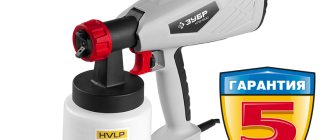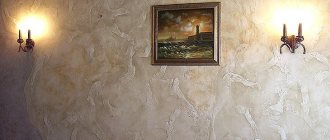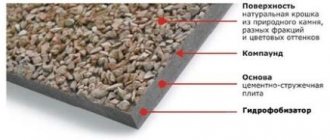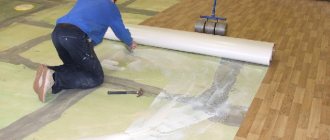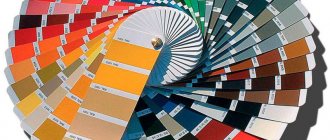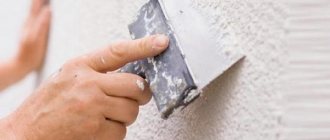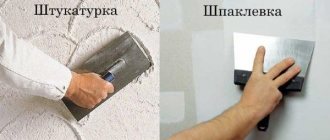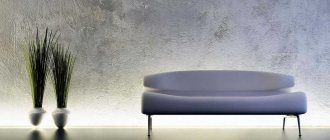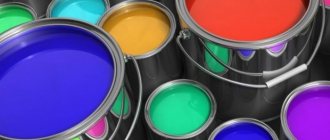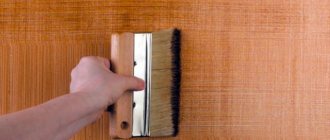Creating color effects in lighting systems has become possible using light sources such as neon lamps, which are gas-discharge lamps and can be filled not only with neon, but also with other gases.
They are actively used by designers, advertisers and decorators; in addition, they are valued by lighting specialists for their reliability and long service life.
In this material we will understand the design features of neon lighting sources, talk about their advantages and disadvantages, as well as how to decorate the interior with their help.
Characteristics
Lamps differ from each other in design and technical characteristics.
It is important for the consumer to know the properties of certain light sources. Let's get to know them in more detail
Power. Measured in Watts. Wattage refers to the amount of electricity that a light source consumes. The larger it is, the brighter the light bulb shines. At the same time, high power indicates high energy costs and the size of the bills.
Since the rated power directly depends on the design, to compare different types of lamps it is more convenient to use another characteristic - luminous flux.
Light flow. Measured in lm. Luminous flux shows how bright the light bulb is. New models of light sources (fluorescent and LED) have greater brightness with less power. It is through this that energy saving is achieved.
Comparative characteristics of the power of the most popular household light bulbs with a luminous flux of 1200 lm are given in the table.
Thus, with equal luminous flux, the power of LED lamps is more than five times less than that of incandescent lamps.
Light output. Measured in lm/W. Luminous efficiency shows the luminous flux per 1 W of power. Also a convenient parameter for comparing different types of lighting fixtures. The higher the light output, the lower the power to ensure maximum brightness.
Color rendering index (Ra, CPI). Shows how real colors are distorted under artificial lighting. It is indicated by numbers from 1 to 100. The lower the coefficient value, the more the shades are distorted. An index of 100 means that colors are reproduced as accurately as possible. For indoor vision, it is safer to use light sources with Ra of at least 80.
Colorful temperature. It is measured in K. It determines the warmth of light, because different colors are perceived differently by the eye depending on the lighting.
Colorful temperature
There are several types of color temperatures:
- 2700-3200 – warm white;
- 3300-4000 – neutral white;
- 4000-5000 – cool white;
- 5000-6000 – daylight;
- over 6000 – cold daytime.
Color temperature significantly affects a person’s mood and performance. When choosing lamps, especially for home and work use, carefully study the labeling. Remember that warm colors promote relaxation, and cold colors promote vigor and efficiency. But in large quantities, cold light depresses the nervous and visual systems. You can read more in the article on color temperature
Life time. This is the number of hours the light source will last. The packaging usually indicates the service life when used under ideal conditions. In reality, it may differ from that declared by the manufacturer. The service life of popular household light bulbs is shown in the table.
In addition, many models of light sources lose brightness over time. This is due to the physical processes that make the glow itself possible. These lamps include LED and gas-discharge lamps.
Light scattering angle. This is the angle at which the light flux diverges. An incandescent lamp shines 360⁰ in all directions. But not all types of light sources can boast the same. For example, due to the design features of LED (and other types), the dispersion angle ranges from 30⁰ to 360⁰.
Light scattering angle
Based on the task of the lamp, the optimal angle is selected. For spot lighting, 30⁰ is enough, but for general lighting it is better to choose the maximum angle.
Ripple (flicker) coefficient. Characterizes the uniformity of illumination. Measured as a percentage. The lower the coefficient, the smoother the luminous flux, the less tired your eyes will be. Ideally, for home and office, you should choose light sources with a pulsation coefficient of about 5%. Lamps with a coefficient above 35% are dangerous for vision.
Neon lamps produced in other countries[edit | edit code]
In other countries, indicator and decorative neon lamps of various designs and dimensions were produced in the past. Currently, only a limited assortment of decorative figured neon lamps is produced, and of the indicator models in mass production, in fact, only one remains - the subminiature NE-2, the design of which has not undergone any significant changes in more than 50 years. However, this lamp is now available in several sizes. The high brightness lamp is designated NE-2H, where H stands for “high”. In addition to conventional lamps of this type, phosphor lamps are also produced: green (NE-2G), blue (NE-2B), white (NE-2W) and others. Moreover, of the phosphor varieties of this lamp, only green is widespread, and models of other colors are scarce [ source not specified 530 days
]. It is also advisable for all NE-2 lamps, especially phosphor lamps, to extend their service life by reducing the current.
Foreign neon lamps with bases, in particular Ba9s, are currently made mainly on the basis of NE-2 lamps, adding bases, resistors (not in all cases) and external bulbs, often plastic.
Advantages and disadvantages
LED lamps have many advantages over incandescent, halogen and fluorescent lamps. Comparative properties are given in the table.
The advantages of LED include:
- Long service life. If all parameters specified by the manufacturer are observed, the LED lamp can operate for up to 50 thousand hours or even more. This is 50 times more than an incandescent lamp, 12.5 times more than a halogen lamp, and 3.3 times more than a fluorescent lamp.
- Maximum light output with minimal power consumption. Their light output is approximately two times higher than that of fluorescent lamps, 4-5 times higher than that of halogen lamps and 7-8 times higher than incandescent lamps. Accordingly, the energy consumption and power of LED lamps of the same luminous flux are less by the same amount.
- Large number of color temperatures.
- Environmental safety, no problems with disposal.
- Structural strength. The lamp can work even with a broken lens.
- Low heating during operation.
- Instant on (unlike fluorescent).
- The number of on-off cycles does not affect performance (unlike fluorescent ones).
- Beautiful appearance.
- Possibility of synchronization with smart home technology.
- The work does not depend on humidity and temperature changes.
- Reduced wiring requirements due to low power LED lamps.
LEDs are not without their drawbacks:
- High price. It is noticeably higher than other types of light sources. Manufacturers are working to reduce costs, but, unfortunately, this often comes at the expense of quality. The price reduction is due to the replacement of the driver with a power supply. After this, the LED lamp quickly fails.
- Sensitivity to changes in mains voltage. The driver levels out differences, so cheap models without a stabilizer quickly fail.
- Flickering (pulsation) of the light flux. Flickering is extremely dangerous for human vision. The optimal pulsation coefficient should not exceed 5%; it is dangerous to use more than 30% at home. Flickering depends on the quality of the design. The absence of a driver dramatically reduces the quality of light.
- A decrease in brightness during operation associated with the physical degradation of LEDs.
- High percentage of defects, especially among inexpensive lamps.
Installation and connection
The installation process of neon lamps is as simple as possible. First, the lighting fixture holder is attached to the selected surface, and only then the light bulbs are installed.
To connect to the network, resistors are used to limit the amount of electric current. In most cases, they are built into the lamp base. It is important to exclude the possibility of transforming a glow discharge into an arc discharge, which is dangerous to humans.
During the installation process, several basic requirements must be met:
- Mounting the converter on metal structures is strictly prohibited. If such a need cannot be avoided, then a special gasket with a thickness of 10 mm or more is used. The distance between the lamp and the metal surface must be at least 40 mm.
- When laying the cable, you need to use distance-type holders, since it must also be distant from metal structures at a distance of at least 30 mm.
- For outdoor installation, additional protection of the wire is important - corrugated PVC hoses are used.
Neon lamps should not be used as primary lighting devices. On the other hand, with their help you can create a unique atmosphere in the house, decorate the facade, summer veranda, gazebo, attract the attention of people passing by the store, and place accents on the most striking and important elements of the interior. With proper and safe installation, you can enjoy the results for several years.
What about the cons?
• The structure is made of glass, so this structure is easy to damage. It is usually recommended (especially in places where there are children), in order to avoid cuts and electric shock, to cover glass tubes with decorative covers made of transparent plexiglass, which does not impair perception in any way, but protects the structure from deformation and the accumulation of dust and dirt.
• It should be noted that there are electrodes at the ends of each tube and a large number of wires can come from one sign, which also need to be hidden in the wall or decorative substrate so as not to get touched.
• It is not recommended to use structures made of neon tubes in rooms with high humidity - bathrooms, swimming pools, spas.
• Let us note that to produce a high-quality neon sign, both for home and business, you need not only a careful craftsman, as they say, “with straight hands,” but also the presence of specialized equipment, which not all enterprises can afford. For example, a neon factory.
• In addition, since a neon lamp requires a step-up transformer of a certain power, proper calculations are required to select a transformer of a given length.
• Neon tube lighting design involves several important aspects that should only be assessed and implemented by professional technicians.
And for dessert, a few words about the largest neon signs in the world:
• Of course, the neon sign that claims to be the largest in the world is located in the “city of neon lights” - the American Las Vegas. This is a sign for the twenty-story Palace Station hotel and casino, consisting of 12,000 neon lamps and having a total length of lighting elements of more than six kilometers!
• To see the second largest neon composition, we will have to go to Hong Kong, where the Canon sign is located, which is 29 meters long and 7 meters high. It consists of 3200 neon lamps, and the weight of this gigantic structure reaches 75 tons!
• The third largest neon sign is also located in Hong Kong and is owned by the Sichuan Jiannanchun Group. Although this design is inferior to the first two in size, it has received well-deserved recognition for its size and successful design solution.
Neon lamp design
A neon lamp is a glass tube filled with a small amount of gas under low pressure. Not a simple gas, but a noble one - neon is one of these. Their characteristic feature is that each atom has a completely filled electron shell, so they do not interact with other atoms, and it will take a lot of energy to tear off at least one electron from them.
There is an electrode at each end of the neon tube. Neon lamps can actually operate on either AC or DC power, but in the latter case only the area around one electrode will glow. That is why most of the neon lamps that we see are powered by alternating current, and a very high voltage - about 15,000 volts. This is just enough to remove an electron from the neon atom from its outer orbit. If the voltage is lower, nothing will work; the electron will not have enough kinetic energy to escape from its atom. Thus, the atoms that have lost electrons receive a positive charge and are attracted to the negative electrode, while the freed electrons are drawn to the positive electrode. All these charged gas particles, called plasma, complete the electrical circuit of the lamp.
Where to get a neon light bulb
Neon gas-discharge bulbs (neons) are presented in a wide range and you can use any available one
Please note that on the left in the photo there is a gas-discharge light bulb with a 200 kOhm resistor, removed from a failed computer extension cord switch, which is also called the Pilot. It can be successfully installed in any switch without the additional hassle of finding components
The same light bulbs with a resistor are installed in electric kettles and other electrical appliances to indicate the on state. In the center of the photograph, a Small-sized Thyratron (triode) with a Cold Cathode MTX-90 unexpectedly appeared. To be fair, I’ll say that the MTX-90 thyratron has been shining in my sconce for decades.
Neon bulbs (neons) surround us almost everywhere. Are you surprised? All older fluorescent light fixtures use a starter, which is a real neon light bulb housed in a cylindrical housing. In order to remove it from the lamp body, you need to turn the cylinder slightly counterclockwise. There are as many starters as there are fluorescent lamps in a luminaire. In the starter, a capacitor is also connected in parallel to the neon lamp; it serves to suppress interference and is not needed in the manufacture of the indicator.
If the starter is taken from an old lamp, before using a neon bulb, do not be lazy to check it. Before installation, you must connect the light bulb according to the above diagram. It is better to take a neon from a new starter, since in old ones the glass of the bulb bulb from the inside is usually covered with a dark coating and the glow will be less visible. A light bulb from a starter can be successfully used to make your own phase indicator.
A ready-made lighting kit for installation in a wall switch can be taken from a faulty modern electric kettle. As a rule, most models have a water heating indicator. The indicator is a neon light bulb with a current-limiting resistor connected in series and this circuit is connected in parallel to the heating element. If you have a faulty electric kettle lying around in your household, then a neon light bulb with a resistor can be removed from it and mounted in the switch.
The photo shows three neon lights from electric kettles. As you can see, they shine quite brightly, so in the dark they will be visible in the switch from a great distance.
If you look closely at the insulating tubes placed at the junction of the terminals of the neon light bulb with the wires, you will notice a thickening on one of the tubes. A current-limiting resistor is located at this location. If you cut the tube lengthwise, a picture will open, as in this photo.
Neon color – what is it?
Many fashionistas are interested in knowing what neon color looks like:
- These shades are very bright and rich, even flashy, and therefore not every fashionista will decide to wear such clothes. Although many people are accustomed to classifying neon colors as bright yellow, light green and orange, there are also neon pink and blue.
- Neon color provides an opportunity to diversify already boring images. It is worth remembering that they are not suitable for everyone, and they also make a girl stand out from the crowd, so you need to think through the smallest details of the look. With the right combination of all the details, the fashionista will look simply incredible.
Who suits neon color?
When choosing such shades, it is important to understand who bright neon colors suit:
- This shade is not suitable for all women. There is a stereotype that such tones look good on teenagers, but adult women can also wear neon clothes, the main thing is to choose them correctly.
- It is worth remembering that neon colors must be used with caution. They are allowed only for ladies who naturally have a bright, contrasting color. When the appearance is not so bright, the neon color can add additional pallor.
- Tones should be chosen so that they match the color of your hair and skin. For example, if dark blue suits a girl, then you can try clothes in neon blue tones. Neon shades must be combined with neutral shades - beige or white. A very interesting combination comes from a bright pink skirt with a white T-shirt.
- If you are afraid to use neon clothes in your image, then you can take accessories. For example, neon shoes are a real trend at the moment.
Important nuances regarding the choice of this color are as follows:
- A small handbag or clutch will dilute the image and attract the attention of others.
- The electric palette should be combined with calm colors. Neon tones go well with pastels.
- You can combine two rich shades in one look, but you need to choose them wisely. For example, green will not look good with purple, but yellow and crimson provide an excellent opportunity to create a look from the eighties.
- You can't go overboard with electric color. For example, a blouse or sweater of such tones looks out of place.
- It is best to try this palette in the summer. Swimsuits look especially impressive.
- The electric palette looks best in a casual or cocktail wardrobe. It is not suitable for daily wear.
What goes with neon color?
To make the image look harmonious, you need to correctly combine neon color with other tones:
- It is important to remember that clothes in such colors are not suitable for office looks, but for an everyday look they are fine. Acid tones are best mixed with basic clothing items. For example, you can wear a hot pink sweater and classic jeans. A yellow turtleneck looks great with a checkered jacket.
- Neon red is an excellent choice for evening outings. An evening dress should be of a simple cut; you should not use many decorative elements and prints.
- If we talk about accessories, there is a very wide choice. For example, a neon clutch can look good with a business suit, a headdress will add bright notes to the look, and shoes will complete it well.
- The best background for acid shades is gray - both matte and shiny. You can combine fabrics of different textures.
- Neon yellow looks good paired with black and white. Strict and well-thought-out silhouettes in clothing are welcomed.
- For parties, a bow entirely in bright colors is also suitable. For example, a lemon dress with matching sneakers is a great combination. Poisonous orange color is also a great solution.
- You can combine several self-sufficient colors in an image, but you should not combine more than three shades. One of them must be basic.
What are neon signs made of?
Various materials can be used as a substrate for neon advertising signs, as well as for LED volumetric letters: ()
Colored or transparent acrylic 3 – 12 mm thick. Multi-colored glass is a good choice if you want to create an unusual, original design. Transparent acrylic, transmitting 90% of light, is almost invisible: it seems as if the bright illumination is freely “floating” in the air
This design looks stylish and instantly attracts attention. PVC is an inexpensive, practical and easy-to-maintain material that is highly resistant to humidity, temperature changes and ultraviolet radiation. The finished structure is often covered with decorative film: multi-colored, mirror, with a glossy or matte surface. Composite materials
Composite panels are lightweight, so they are often used to reduce the overall weight of neon outdoor and indoor advertising. Wood – the use of hardwood and proven processing technologies ensures neon signs are resistant to deformation, rotting and drying out. To decorate themed establishments, wooden structures can be given a resemblance to antiques by brushing (artificial “aging”). Metal – these neon signs look “expensive” and elegant. When creating advertising, aluminum or stainless steel is usually used. Metal signs are durable, wear-resistant and weather-resistant, making them suitable for outdoor use.
Combining several materials is a good way to get an exclusive product. Thus, a wooden structure can be framed in a metal frame.
Production stages.
Creating LED neon signs begins with preparing the layout. The sketch is performed in specialized computer programs. After the project has been agreed upon with the customer, the material selected for the substrate is sent for milling. The use of milling machines is the optimal processing method, allowing:
- Receive workpieces of any size and configuration.
- Achieve full compliance with the specified parameters.
- Complete even the most complex work in the shortest possible time.
- Eliminate the possibility of releasing defective products due to full automation of equipment.
After making the substrate, neon strips are laid into the prepared holes and closed with plugs at the ends. All connections are carefully sealed to ensure structural integrity and avoid premature failure.
You can place lighting made of flexible neon even in hard-to-reach places. However, it is problematic to carry out installation without experience and specific knowledge, so it is recommended to entrust such work only to professional specialists.
Where do they get neon?
The first neon was made in 1910 by Georges Claude, but for his invention he used the work of Maurice Travers and William Ramsay, English chemists who obtained neon by eliminating it from the air as a by-product. In atmospheric air, the maximum concentration of Ne reaches 0.00182%. This is very small on a planetary scale, but enough for its production in industrial quantities.
The method for producing neon is to liquefy all the heavy components of air, resulting in the formation of a residual non-liquefied component - a helium-neon mixture. Three methods are used to separate helium and neon:
- adsorption of neon by cooled activated carbon;
- freezing with liquid hydrogen;
- double rectification in the condenser-evaporator;
- cold rectification of compressed mixture.
It is the latest technology that makes it possible to obtain gas of 99.9% purity on an industrial scale.
Video: Neon is the most INERT gas on EARTH
Apartment neon lighting options
On the market of goods and services, among neon lighting devices you can find strips, which many call flexible neon. In appearance, the ribbons resemble a garland, which is located in a tube made of PVC material.
Flexible backlights can be multi-colored or monochromatic. During the production process, high quality materials are used, as a result of which the tubes can be matte or transparent. Single-color options are exclusively matte.
Such strips, unlike light bulbs, have a large number of advantages, among which are:
- the likelihood of causing damage is minimal, glass lamps are quite easy to break, which is why they are considered dangerous:
- presence of waterproofing;
- since the tape is flexible, it can be installed absolutely anywhere;
- Unlike LED lamps, neon strips are much cheaper.
Due to such demand, it is likely that many lighting devices will be forced out of the market for goods and services.
Important! Neon lights, unlike other light sources, have a fairly wide range of light.
Neon lamps for apartments
Neon lamps can be used in living spaces to illuminate furniture. This way you can fill the room with unusual and bright color tones. Most often, this option is used when the room contains upholstered or glass furniture.
In addition, you can use additional light for decorative elements and accessories. For example, in close proximity to paintings, in niches, around large mirrors, tall indoor plants.
It is important to understand that neon lamps can be used in a living space not only as a bright accent. For example, such lighting fixtures are often used to brighten stairs or baseboards.
If necessary, light sources can be mounted in pieces of furniture in the kitchen area.
An interesting option is lighting sculptures made of plaster, glass or fabric. In a room, a beautiful sculpture will look much more impressive as a light source than an ordinary lamp. Today, lamps made in the shape of birds made of glass or wood are popular.
Advice! By giving preference to neon lighting to decorate the design of the room, you can create a wonderful design that will create a festive atmosphere.
Flexible neon lights
Flexible tapes look quite organic and presentable in the design. With their help you can give the room some zest. In addition, you can take them with you to nature, which will create an unusual atmosphere.
Flexible devices are indispensable in everyday life; they can be used to illuminate the ceiling around the entire perimeter, creating a floating effect, or be mounted in an aquarium or furniture. If necessary, you can make the light turn on when the cabinet door is opened, using neon laces for this purpose.
Such light sources fit perfectly into the kitchen, as they can be mounted in furniture above the work surface. Due to their flexibility, such tapes can be used on any surface and given the desired shape.
How do they work?
A neon lamp consists of a bulb in which the following processes occur: when moving, electrons collide with neutral gas atoms, which are fillers in this area, and begin to ionize them, pushing electrons from the upper area into the container. The atoms, in turn, collide with electrons, again becoming neutral atoms. Thanks to this reverse transformation, a quantum of light energy is emitted. As you can see, the operating principle of neon lamps is not very complicated.
To calculate the required illumination of a room, you can use the appropriate calculator.
When turned on, such devices do not heat up much - the heating temperature reaches a maximum of 80 °C. It is for this reason that neon tubes are also commonly called cold cathode lamps. Their scope of application is quite wide, as they are durable, economical and functionally flexible. The main advantage of such light bulbs is that they can have any shape you like.
Any inert gas and metal vapor has its own spectral light composition:
- helium tubes emit light yellow or pale pink light;
- neon tubes - red light;
- argon tubes - blue light.
How to make a light bulb that glows in the dark
Take our half-liter bottle of Mountain Dew and boldly pour ¾ of the liquid out of it. You can drink it if you don't mind the ingredients. Thus, only a quarter of the soda will remain in the bottle. Carefully measure out ¼ tsp. soda
Carefully pour it through the neck of the bottle. Measure out 3 bottle caps of hydrogen peroxide and pour them one at a time into the bottle. Now screw on the lid and shake the mixture. If everything was measured carefully, then turn off the light and watch how our neon liquid glows in the darkness.
This wonderful liquid can be coated with an ordinary incandescent lamp. It is advisable to secure it to give the composition a chance to dry and then connect it to the network. You can coat a fluorescent lamp, a flashlight, and many other objects (for example, an electric guitar, a sign, a mask, Christmas tree decorations) with a neon composition.
To all brain friends
, good day! Here is a guide on how to create another brain light
, which, however, stands out from everyone else with its “coldness” :).
I collected three of these “cold” homemade products
, each of which glows in its own color, and I believe everyone can do it with their own hands
make one like this for yourself.
For this you need (components are designed for 3 lamps):
- several spare parts from a copper lamp
- three bulbs from 300W light bulbs (small or large, your choice, or a glass bottle or something similar)
- 6 UV LEDs and resistors for them for 9V
- 3 9V batteries
- 3 switches
- textile braided cable
- acids and potassium sulfide for coloring
- thin wires
- distilled water
- glue gun
Step 1: Stand or Case
First you need to separate the bulb bulb, and there are many tutorials
. Be careful and careful during this process, as the glass of the flask is very fragile!
The second photo shows pendants with empty flasks, and the third with painted bases.
Next, we glue a UV LED into the stand, directly under the bulb, and solder the second UV LED in parallel using a braided cable. Leave this cable long enough so that it can be trimmed if necessary.
Step 2: Flask Holder
Connecting your brain imagination
We make three flask holders, I made them in the form of spirals.
Then, calling Dremel and Proxxon to help :), we cut the test tube to a length of about 10cm. We drill a hole in the test tube stopper for the second UV LED and glue it in using a glue gun.
At the same time, we “invent” caps for the test tubes, for example, as in the second photo. After that, for every brain teaser
we mount the switches and connect them to the LED circuits (third photo).
The switch is working. Video
You can learn about the joint operation of an LED lamp and an illuminated switch in this video.
All calculations made in the article are valid for the normal glow mode; when using them for switches, the resistor values can be adjusted to increase by 2-3 times. This will reduce the brightness of the LED, neon and the power dissipation of the resistors, and therefore their dimensions.
If a capacitor is used as a damping resistance, then its value must be adjusted downwards to reduce brightness, as well as dimensions, but the operating voltage of the capacitor cannot be reduced.
Reducing the current through the backlight reduces the likelihood of energy-saving lamps flickering in the dark, since the charge level of the input capacitor in the pulse converter of these lamps does not reach the start threshold.
Our comfort comes from little things. Such a small detail - the backlight of the switch - but there are many advantages from it. How to connect a backlit switch so that everything works without problems, how to “make friends” with LED and energy-saving lamps, how to make sure that this small improvement does not “draw” a lot of electricity. All this is in the article.
In electrical switches, the backlight is an LED or neon bulb. Outwardly, they are little distinguishable, but neon lights consume less electricity, but create a larger voltage drop. For LEDs, the minimum glow current is 2 mA and the voltage drop is 2 V, for neon bulbs in the backlight - 0.1 mA and 70 V, respectively. And this should be taken into account when choosing.
Another important point: the switch backlight may not work correctly with all types of lamps. The backlit switch works with incandescent and halogen lamps without any problems. But with energy-saving and LED ones, it is better not to install them or take special measures. If you just connect it, there may be problems. The most common ones are that the backlight will not light up or the light will blink when turned off.
If we talk about the number of keys, then the backlight can be on a switch with any number of keys: one, two, three or even four (if you find them). In addition, they can be both on regular models and on walk-through models. The location of the luminous point is also different: on the key or on the body. On the key it can be at the top or in the middle, on the body - at the center at the top or bottom.
DIY temporary lava lamp
Of course, you can go to the gift shop and purchase this piece of furniture. But it's not that cheap. Let's look at how to make a lava lamp from scrap materials?
The first thing we need is a large plastic bottle of lemonade or mineral water. In general, absolutely any transparent container that closes tightly with a lid will do, but a plastic bottle is the best option. In order to achieve the most effective result, it is better to take a container of at least 0.5 liters.
Next, you need to fill the bottle with oil three-quarters of the entire volume, and fill the remaining quarter with water and about 10 drops of food coloring. The solution should be rich in color. Now you need to add salt or any effervescent tablet, such as Alka-Seltzer or vitamin C.
Next, tightly cap the bottle and shake it. You will immediately notice how droplets of liquid begin to form, gradually connecting with each other. But this process will not occur continuously. Over time, the drops will stop forming and you will have to add more salt or effervescent tablets.
This kind of lava lamp, made with your own hands, is good because it is absolutely harmless and safe, which is important if it is to be used, including by children.
To make everything look even more impressive, install some kind of light source at the bottom of the bottle so that the beam is directed upward onto the liquid. This way, the light will illuminate these droplets, and the lava lamp will look much more impressive. You can destroy it with your own hands if the light source produces a lot of heat, which can melt the plastic.
Application
Decorative neon lamp
Decorative neon lamp, electrodes covered with phosphor.
- Thanks to the very low current consumption, the neon lamp is a simple, economical and reliable indicator of the inclusion of 220 volt mains voltage.
- There are relatively large neon decorative lamps designed for installation in a standard E14 or E27 socket and operating on a voltage of 220 V. In the USSR, such lamps were usually sold only in combination with night lights, and the electrodes had a relatively large area and could be shaped - for example, in the form of a curved candle flame. Currently, lamps of this type continue to be produced in China. Decorative lamps contain a built-in ballast resistor, which allows them to be connected directly to the lighting network.
- The minimum current required to ignite low-pressure neon lamps is so small that even the capacity of the human body can provide it, that is, such lamps are very sensitive. This is used in indicator probes that make it possible to detect the presence of alternating voltage on the phase wire of a lighting electrical network or on device housings. Such a probe must necessarily
contain a resistor with a nominal value of about 1 MOhm, connected in series with the neon lamp, to prevent the possibility of electric shock to a person. - Like almost all gas-discharge lamps, a neon lamp can light up without direct electrical power - from exposure to an electromagnetic field, for example, from an HF transmitting antenna, plasma lamp or Tesla transformer. An example of such a lamp is the Balizor lamp, used to illuminate high-voltage power line wires.
- A neon lamp is used in a stroboscopic device for controlling the rotation speed of an electric record player.
- A neon lamp can be used not only as an indication element. Due to the presence of negative dynamic resistance, it can also act as an active element, although here it is somewhat inferior in versatility to the glow discharge thyratron. It is most often used in this capacity in relaxation generators, and is also used as a threshold element. It can also be used in more complex circuits: for example, counters can be made using neon lamps.
A neon lamp can also be used as a protection element against short-term overvoltages in signal circuits of the corresponding voltage (if the permissible voltage of the protected circuit is below its ignition threshold, and voltage surges reach it), for example, in telephone lines (in the input circuits of telephone sets).
Color variety of gas light lamps
The color range of neon devices is really wide. The shades depend on the selected gas, on the composition of the substance applied to the glass and on the gas additive to the noble filling of the tube. They can change intensity due to current instability. When separated, the electrons of noble gas atoms release energy, which determines the wavelength of light, and therefore the color.
Contrary to popular belief, according to which neon lamps glow blue or lilac, devices with neon filling have a red or orange glow. By the way, mercury vapor is not needed to increase the brightness of red lamps - the light is already saturated
If you use pure inert gases in the tubes, they will produce the following colors:
- helium – pink;
- krypton – green;
- argon – lilac or blue.
Other colors are also available. To do this, mix various gases, change their proportions, and apply phosphors on the inside of the glass. For example, using krypton as phosphor-coated tubes, you can obtain a wide range of yellow shades.
The density and frequency of the electrical current can also affect the color change. If we take a neon lamp as an example, then when the current density decreases, the glow will become orange, and when it increases, it will move into the blue segment of the glow spectrum.
In addition to krypton and argon lamps, fluorescent lamps can glow blue and lilac; they are often confused. Ultraviolet lighting, which is often used in nightclubs and discos, has a similar glow.
In order for the effect of ultraviolet lamps to be present in gas-discharge devices, they are filled with xenon or krypton. Sometimes they use mixtures of them in various proportions and a mix with argon.
There is an article on our website where we talked in detail about ultraviolet lamps for home use. Read on for more details.
